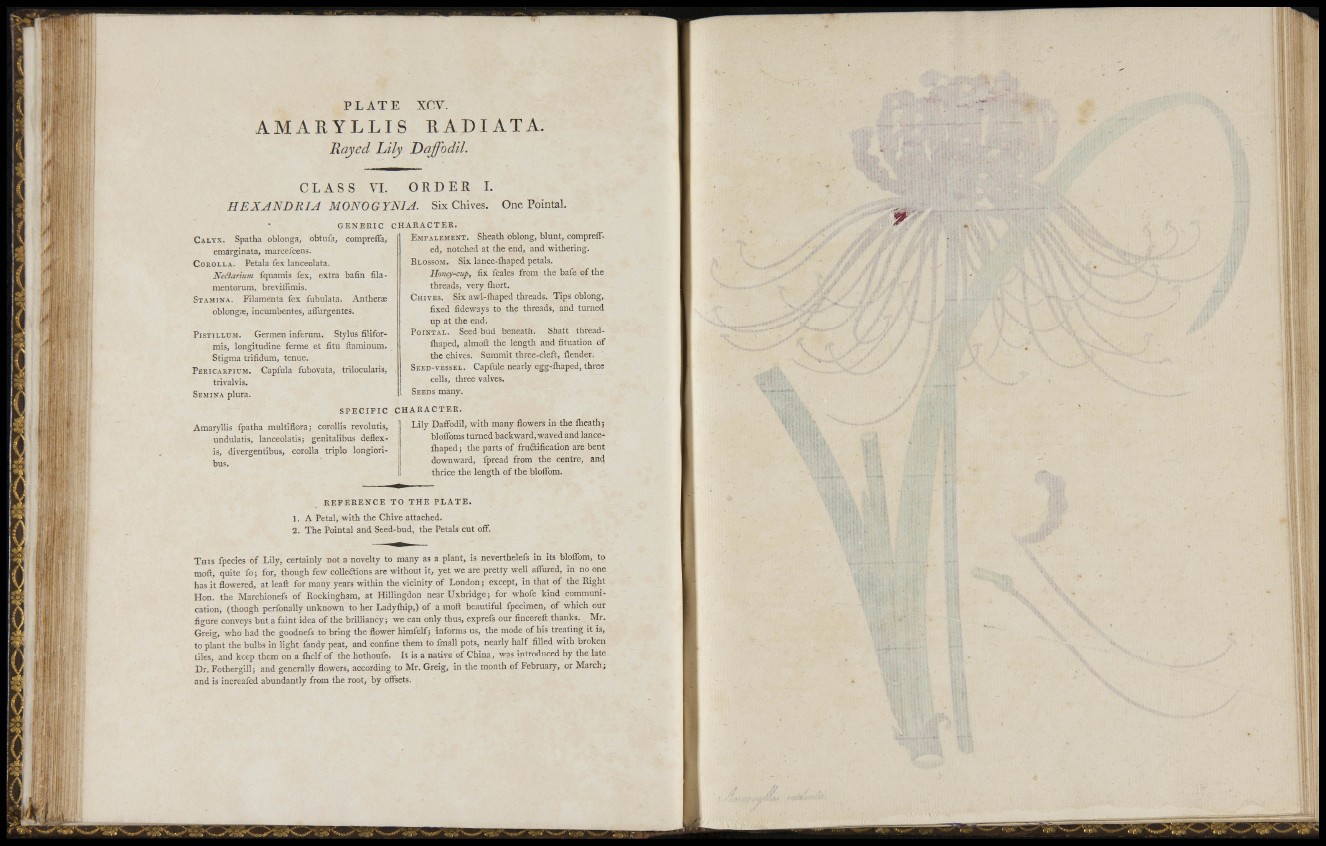
m fl!|--
f ! l
m
PLATE XCV.
A M A R Y L L I S RADIATA,
Rayed Lily Daffodil.
C L A S S \L ORDER L
HEXANDRIA MONOGYNIJ. Six Chives. One Pointai.
G E N E R I C
CALYX. Spatha oblonga, obtufa, compreffa,
emarginata, marcelcens.
COROLLA. Pétala lex lanceolata.
Neéiarìum fquamis fex, extra bafin filamentorura,
breviffimis.
STA.MINA. Filamenta fes fubulata. Anthers
oblongEe, incumbentes, atTurgentes.
PisTiLLU.M. Germen inferum. Stylus filiformis,
longitudine ferme et fitu ftaminum.
Stigma trifidum, tenue.
PEKICAKPIUM. Capitila fubovata, trilocularis,
trivalvis.
SEMINA plura.
S P E C I F I C
Amaryllis fpatha multiflora; corollis revolutis,
undalatis, lanceolatis; genitalibus defies •
is, divergentibus, corolla triplo longioribus.
C H A E A C T E R .
EMPALEMENT. Sheath oblong, blunt, compreiTed,
notched at the end, and withering.
BLOSSOM. Six Innce-fliaped petals.
Honey-cup, fix fcales from the bafe of the
threads, very fliort.
CHIVES. Six awl-fliaped threads. Tips oblong,
fixed fideways to the threads, and turned
up at the end.
POINTAL. Seed bud beneath. Shaft threadfliaped,
almoft the length and fituation of
the chives. Summit three-cleft, flender.
SEED-VESSEL. Capfule nearly egg-fliaped, three
cells, three valves.
SEEDS many.
C H A B A C T E K .
Lily Daffodil, with many flowers in the flieath;
bl offoms turned backward, waved and lanceiliaped;
the parts of fruftification are bent
downward, fpread from the centre,
thrice the length of the bloflbm.
and
K E F E R E N C E TO THE PLATE.
1. A Petal, with the Chive attached.
2. The Pointal and Seed-bud, the Petals cut off.
T H I S fpecies of Lily, certainly not a novelty to many as a plant, is neverthelefs in its bloflbm, to
moft, quite fo; for, though few colleaions are without it, yet we are pretty well afliired, in no one
has it flowwd, at leaft for many years within the vicinity of London; except, in that of the Right
Hon. the Marchionefs of Rockingham, at Hillingdon near Uxbridge; for whofe kind communication,
(though perfonally unknown to her Ladyfliip,) of a moft beautiful fpecimen, of which our
figure conveys but a faint idea of the brilliancy; we can only thus, exprefs our fincereft thanks. Mr.
Greig, who had the goodnefs to bring the flower himfelf; informs us, the mode of his treating it is,
to plant the bulbs in light fandy peat, and confine them to fmall pots, nearly half filled with broken
tiles, and keep them on a ihelf of the hothoufe. It is a native of China, was introduced by the late
Dr, Fothergill; and generally flowers, according to Mr. Greig, in the month of February, or March;
and is increafed abundantly from the root, by offsets.
"Uh
t:
, V. : • ••
• :'i„
' i. 1
l: i,i